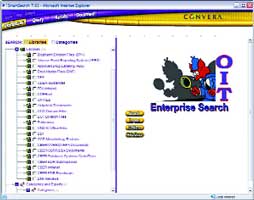FDA gets enterprising with new search tool


Connecting state and local government leaders
Scientists who review new drug applications for the Food and Drug Administration face a long, winding road in finding all the information they need. FDA has 23 searchable libraries or databases, containing more than 5 million documents and 34GB of indexes.

"We're sharing information and getting more standardized, so when they go out to search they don't have to play with different search tools." ' Helen Mitchell, FDA
Rick Steele
Studies documenting favorable outcomes or negative reactions to certain treatments, for instance, could be available but unknown to researchers because older search engines cannot see across standalone systems or determine all the categories under which the materials are located.
FDA officials are planning to remedy that with a new search program.
The Enterprise Search application is designed to take disparate collections of information in agency databases or libraries and make them easily searchable by users across the agency, said Helen Mitchell, project manager for the enterprise search program in FDA's Office of the CIO.
'It's going to provide the ability to do one-stop shopping for the information you need to get, the most meaningful search results or the most meaningful documents to do your job. We're not all the way there, but that's the direction we're going,' Mitchell said.
Better search results
FDA is moving toward an information architecture that will yield more relevant search results, said Fred Farmer, FDA acting CIO.
'We're evolving into a more information-centric organization by developing search strategies, nomenclature standards, seamless interfaces and taxonomies,' he said.
FDA is testing integration of Enterprise Search with the agency's intranet portal, called Inside FDA. Enterprise Search, which will appear as a button on the portal, will be able to search across all of FDA's eight centers and top-level agency sites.
'Users are going to be able to come in there and do any of their business, not only search for things across the intranet. They'll be able to do single sign-on to get to applications and access any content put into the (intranet),' Mitchell said.
FDA also will put in place a content management system to better manage documents and profiles for scientific reviewers and law enforcement, she said.
Previously, scientists, reviewers and other employees had to perform searches center by center. What Mitchell heard from reviewers and agency employees in various disciplines was, 'The biggest bottleneck is finding information that we need.'
Users like software
Scientists who were surveyed after using the foundation software for a year told Mitchell that they were able to provide higher-quality drug reviews because they found information they couldn't previously find or didn't have time to look for.

Enterprise Search is approaching the point where the application is expected to show big results. FDA launched the program in 2004 but has been installing RetrievalWare software, the underlying technology for Enterprise Search, across the agency for 10 years. Convera Corp. of Vienna, Va., makes RetrievalWare.
FDA has developed Enterprise Search with a layered approach based on user needs, as opposed to a phased approach, said Maher Darwish, FDA program manager at MacFadden of Silver Spring, Md., the integrator for Enterprise Search.
FDA is taking a more unified approach now, Mitchell said.
'We're sharing information and getting more standardized, so when they go out to search they don't have to play with different search tools,' she said.
FDA plans to integrate Enterprise Search into the agency intranet either by center or by discipline of scientific reviewers. Mitchell expects the first group, however FDA decides to put it in production, to have that capability within the next three months.
Mitchell's goal is to have the Enterprise Search working across the agency in five years.
The Center for Drug Evaluation and Research uses RetrievalWare with its Adverse Event Reporting System. The Oracle relational database management system contains data about drug product information, drug reactions and population groups. For example, CDER employees can search for all deaths of females in the western United States between the ages of 50 and 60, and who had been hospitalized or died within a time period.
The system sends back a list of event reports that meet the search criteria. If the documents were scanned in, a button pops up on the screen that asks the user to view the image and retrieve it, or choose to print out the data in a batch mode to read later.
RetrievalWare's semantic- search and fuzzy-search capabilities are what makes Enterprise Search effective, Mitchell said. With fuzzy search, RetrievalWare uses patterns in words to return results, even if a drug is misspelled. Semantic search finds documents based on similar concepts and then allows the user to pinpoint the precise information needed within a category.
Adding a sense of urgency to being able to find information, FDA is moving to new headquarters in White Oak, Md., which has less shelf space. As a result, employees have been scanning paper documents into electronic form. The RetrievalWare also helps with the naming convention to determine in which buckets or classifications those documents will reside.
FDA awarded MacFadden a five-year blanket purchase contract for $16 million last August to integrate Enterprise Search with the Oracle databases and applications and including integration of Convera RetrievalWare.
NEXT STORY: PTO ruling gives BlackBerry users hope




